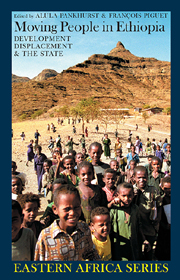Book contents
- Frontmatter
- Contents
- Acknowledgements
- Acronyms
- Glossary
- Notes on Contributors
- Preface: An Original Contribution to Country-wide Displacement Analysis
- Foreword by Alula Pankhurst & François Piguet
- Map
- Part I INTRODUCTION
- Part II THEORETICAL & INTERNATIONAL PERSPECTIVES
- Part III DEVELOPMENT-INDUCED DISPLACEMENT
- Part IV THE EXPERIENCE OF STATE-ORGANIZED RESETTLEMENT
- 9 Why Did Resettlement Fail?
- 10 Social Impact of Resettlement in the Beles Valley
- 11 Revisiting Resettlement under Two Regimes in Ethiopia
- Part V THE DILEMMAS OF REFUGEES, RETURNEES & DISPLACED GROUPS
- Part VI CONCLUSION
- Bibliography
- Index
- EASTERN AFRICAN STUDIES
11 - Revisiting Resettlement under Two Regimes in Ethiopia
from Part IV - THE EXPERIENCE OF STATE-ORGANIZED RESETTLEMENT
Published online by Cambridge University Press: 05 April 2013
- Frontmatter
- Contents
- Acknowledgements
- Acronyms
- Glossary
- Notes on Contributors
- Preface: An Original Contribution to Country-wide Displacement Analysis
- Foreword by Alula Pankhurst & François Piguet
- Map
- Part I INTRODUCTION
- Part II THEORETICAL & INTERNATIONAL PERSPECTIVES
- Part III DEVELOPMENT-INDUCED DISPLACEMENT
- Part IV THE EXPERIENCE OF STATE-ORGANIZED RESETTLEMENT
- 9 Why Did Resettlement Fail?
- 10 Social Impact of Resettlement in the Beles Valley
- 11 Revisiting Resettlement under Two Regimes in Ethiopia
- Part V THE DILEMMAS OF REFUGEES, RETURNEES & DISPLACED GROUPS
- Part VI CONCLUSION
- Bibliography
- Index
- EASTERN AFRICAN STUDIES
Summary
Introduction
Over a million people have been resettled in Ethiopia in two phases: over 200,000 households representing a little under 600,000 people in 1985-6 under the Derg and about 190,000 households and around 627,000 people during 2003-7 under the EPRDF. This chapter considers the following nine questions: Was it a coincidence that resettlement was promoted at times of famine in the mid-1980s and early 2000s? Why was further resettlement deemed necessary when the earlier resettlement was known to have been a failure? What are the similarities and differences between the two programmes? Were the mistakes committed in the earlier resettlement avoided? How far has the current resettlement adhered to the principles and guidelines set out? Have the economic costs and financial implications of resettlement been taken into consideration and properly analysed? What are the longer-term consequences of resettlement? How could resettlement planning and practice be improved on the basis of the current and past experience? Is there an alternative model that might work better?
The Derg resettlement has been the subject of considerable research including three PhD theses (Pankhurst 1989; Gebre 2001; Wolde-Selassie 2002), several books (Alemneh 1990; Dieci and Viezzoli 1992; Pankhurst 1992a; Wolde-Selassie 1998; Dessalegn 2003) and a large number of reports and articles.
- Type
- Chapter
- Information
- Moving People in EthiopiaDevelopment, Displacement and the State, pp. 138 - 179Publisher: Boydell & BrewerPrint publication year: 2009



